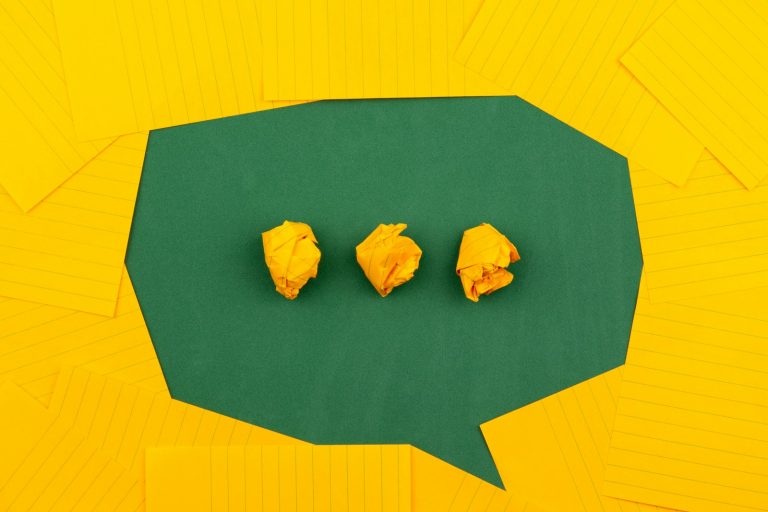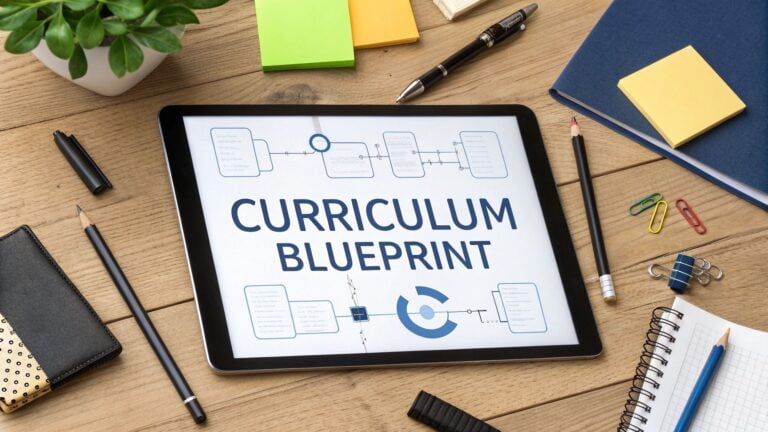Your Guide to Making a Lesson Plan That Works
Think of a lesson plan as your roadmap for the classroom. It’s the document that spells out what you want your students to learn, the activities you’ll use to get them there, and how you’ll know if they’ve actually arrived. It’s what turns potential chaos into a focused, purposeful experience for everyone.
Why a Good Lesson Plan Is Your Best Friend

When you’re a new teacher, the to-do list is a mile long. It’s so tempting to see lesson planning as just another box to check off. I’ve been there. But I learned pretty quickly that carving out time to create a solid plan was the most valuable thing I could do for my students and for my own sanity.
A lesson plan is your strategy. A well-thought-out plan is your best defense against the beautiful, unpredictable nature of a classroom full of kids. It gives you a clear structure that keeps everyone on track, even when the volume gets a little wild or a fire drill cuts you off mid-sentence.
Boost Your Confidence and Reduce Stress
There’s a world of difference between walking into a classroom prepared and walking in just hoping for the best. I can still feel the knot in my stomach from my first year, right before a particularly tricky grammar lesson. But because I had a detailed plan with clear steps, engaging activities, and even some backup questions, I felt in control.
That confidence is contagious. When you’re calm and prepared, your students feel more secure and are way more likely to jump into the lesson with you. A good plan also slashes the number of in-the-moment decisions you have to make. This frees up your mental energy to focus on what really matters, which is connecting with your students.
Here’s what a solid plan really gives you:
- A Sense of Purpose: Every single activity connects back to a specific learning goal. Nothing feels random or like busywork.
- Better Classroom Management: When students are engaged in a well-paced, interesting lesson, there’s just less room for off-task behavior.
- A Professional Tool: It’s a concrete way to document your teaching, share ideas with colleagues, and show administrators your thoughtful approach to your craft.
Learning from Experience
Of course, I’ve learned this the hard way, too. There were days I tried to “wing it,” thinking I knew the material well enough to just talk through it. One time, a simple discussion I’d penciled in for ten minutes completely fizzled out in two. That left me with 43 minutes of dead air and a room full of restless fifth graders.
It was a disaster. I promised myself never again.
Your lesson plan is your roadmap. It doesn’t mean you can’t take detours or explore interesting side roads with your students, but it ensures you always know how to get back to your destination.
Think of it this way: a great lesson plan empowers you to be more flexible, not less. Because you have that strong foundation, you can confidently chase a student’s great question, seize a teachable moment, or handle an unexpected interruption without completely losing sight of your goals. It’s the difference between being a tour guide with a map and just being lost in the woods.
Define Your Destination with Learning Objectives
So, where do you actually start when you sit down to make a lesson plan? It all begins with a simple but surprisingly powerful question: What should my students know or be able to do by the end of this lesson?

Getting a crystal-clear answer to that question is the single most important first step. Those answers become your learning objectives. They act as the guiding star for every other decision you’ll make, from the activities you choose to the way you check for understanding at the end.
Think of it like planning a road trip. You wouldn’t just get in the car and start driving aimlessly. You’d pick a destination first. Your learning objectives are that destination.
Why Fuzzy Goals Don’t Work
I used to write objectives like, “Students will understand the water cycle.” On the surface, that sounds perfectly fine, right? But how do you actually measure “understanding”? It’s just too vague.
This is a really common pitfall, and it leads to a fuzzy lesson. If I don’t know exactly what I’m aiming for, how can I design activities that will get my students there? More importantly, how will I know if they’ve actually learned anything?
The key is to use strong, measurable action verbs. These are words that describe something you can actually see a student do or assess in a tangible way.
“A well-defined learning objective acts as a contract between the teacher and the student. It clearly states what will be learned and how success will be measured, removing ambiguity and focusing the learning process.”
This isn’t just a nice idea. It’s backed by solid research. Studies show that classrooms where teachers build lessons around measurable outcomes see up to a 25% improvement in knowledge retention. You can dive into the data yourself by checking out the full report on global teaching practices. Clear objectives give students a roadmap, and that structure makes a huge difference.
The Power of Strong Action Verbs
The secret to writing great objectives lies in the verb you choose. Ditching words like “understand” or “learn” for verbs that demand a specific action from the student changes everything.
Here’s a quick comparison to show you what I mean:
Fuzzy Verb: Understand the causes of the American Revolution.
Action Verb: Identify three primary causes of the American Revolution.
Fuzzy Verb: Learn about plant cells.
Action Verb: Label the five main parts of a plant cell diagram.
Fuzzy Verb: Appreciate poetry
Action Verb: Analyze the use of metaphors in a given poem.
See the difference? The second version of each objective is specific and measurable. I can easily create an activity and an assessment to see if a student can identify, label, or analyze. There’s no guesswork involved.
Connecting Objectives to Standards
Now, you might be thinking about curriculum standards. Every district and state has them, and it’s our job to make sure our lessons are aligned.
Don’t let that long list of standards overwhelm you. Think of them as a resource. Find the standard that matches your lesson idea, and then use its language to help you craft a student-friendly objective.
Let’s walk through a real-world example. Say I’m a 4th-grade science teacher, and we’re working on energy transfer.
- The Standard: NGSS 4-PS3-2: Make observations to provide evidence that energy can be transferred from place to place by sound, light, heat, and electric currents.
- My Lesson Idea: I want to do a fun, hands-on activity with circuits.
- My Learning Objective: By the end of this lesson, students will be able to construct a simple circuit that successfully lights a bulb and explain how energy is transferred from the battery to the bulb.
This objective is directly tied to the standard. But it’s written in a way that is clear, actionable, and focused on what my students will do.
This single, well-crafted objective now dictates the rest of my plan. I know I need batteries, wires, and bulbs. I know my final check for understanding will involve students explaining the process. Suddenly, planning the rest of the lesson becomes so much more straightforward because I know exactly where we’re headed.
Design Engaging Activities and Assessments

This is where lesson planning gets really fun. You’ve already done the hard work of defining your learning objectives. That’s your destination. Now, it’s time to actually map out the journey with activities and assessments that will get your students there.
I always think of this part as moving from the “what” (the objective) to the “how” (the activities). You’re bringing the lesson to life, creating an experience that is effective and actually clicks with your students.
Choosing the Right Instructional Strategies
Your teaching toolbox is packed with methods, and there’s no need to reinvent the wheel for every single lesson. The real trick is picking the right tool for the job. You wouldn’t use a hammer to saw a piece of wood, right? Same idea here. A lecture just won’t cut it for a skill that demands hands-on practice.
I always aim for a mix of activities to keep things fresh and appeal to different kinds of learners. Think about weaving some of these classics into your plan:
- Direct Instruction: This is you, front and center, explicitly teaching a concept. It’s perfect for rolling out new information, modeling a process, or clearing up something complex.
- Think-Pair-Share: A beautifully simple but powerful strategy. You pose a question, give students a quiet moment to think, let them hash it out with a partner, and then open the floor for class discussion.
- Hands-on Projects: Nothing beats learning by doing. Whether it’s building a model, running an experiment, or creating art, projects let students apply what they know in a tangible way.
- Class Debates or Discussions: These are fantastic for building critical thinking and communication skills. They push students to form opinions, back them up with evidence, and really listen to different perspectives.
Over the years, I’ve found that a little friendly competition can do wonders for motivation. If you want to dive deeper into this, check out the principles of gamification for eLearning, which are surprisingly easy to adapt for any classroom.
Sequencing Your Activities for Maximum Impact
Once you’ve got a few activity ideas brewing, the next step is putting them in an order that makes sense. A well-sequenced lesson builds momentum and helps students connect new information to what they already know.
I’m a big fan of the classic “I do, we do, you do” model. It just works.
I Do (Modeling): I kick things off by introducing the concept myself. This could be a demonstration, a think-aloud to show my thought process, or just a clear explanation with solid examples. This is all about laying the foundation.
We Do (Guided Practice): Next, we practice it together. We might work through problems as a class, collaborate on a small task in groups, or do a quick think-pair-share. This phase is absolutely crucial for building confidence and catching misconceptions early.
You Do (Independent Practice): Finally, it’s their turn to fly solo. Students get to apply the skill on their own, showing what they’ve learned through an independent task, a project, or a quick assessment.
This simple sequence provides a natural scaffold, supporting students as they move toward independence.
Assessment Is More Than Just a Grade
When most people hear “assessment,” their minds jump straight to tests and grades. But in the context of a lesson plan, assessment is really about something much simpler. It’s about checking for understanding as you go.
These quick checks are called formative assessments, and they are your best friend for knowing if your lesson is actually landing. They give you real-time feedback, allowing you to pivot and adjust your teaching on the fly.
Assessment isn’t just about finding out what students know. It’s about finding out what they need next. It’s a compass that helps you navigate the lesson in real-time, ensuring no one gets left behind.
Think of it as taking the temperature of the room. A quick check-in can tell you if you need to slow down, circle back to a concept, or if everyone’s ready to move forward.
This immediate feedback loop is invaluable. It helps you spot students who are struggling before they get left in the dust and lets you know when the class has mastered a concept and is hungry for a new challenge. It transforms your lesson plan from a rigid script into a flexible, responsive guide.
Here are a few of my favorite, low-prep formative assessment techniques:
- Exit Tickets: Before students pack up, ask them to answer one quick question on a sticky note or index card. It could be, “What was the most important thing you learned today?” or a single problem to solve.
- Thumbs-Up/Thumbs-Down: This is the fastest check-in there is. Just ask students for a thumbs-up if they feel confident, a thumb-to-the-side if they’re a bit shaky, or a thumbs-down if they’re totally lost.
- Whiteboard Check: Have students work out a problem on individual mini-whiteboards and hold them up. You can see everyone’s work at a glance and spot common errors instantly.
Find a Lesson Plan Template That Fits You
You don’t have to stare at a blank page every time you sit down to plan. Trust me, nobody has time for that. Using a lesson plan template can be a massive time-saver and a great way to make sure you’ve covered all your bases.
But here’s the thing: there isn’t one perfect template for everyone. The best one is the one that actually works for you and your teaching style. The goal is to find a system that makes planning feel efficient, not like a chore you have to slog through.
The whole process of lesson planning has really evolved. What started as a simple oral tradition became a formal requirement by the early 20th century to keep teaching consistent. Today, data shows that over 90% of teachers use them systematically, and for good reason. A National Center for Education Statistics survey found that 92% of teachers who prepared daily written plans saw a positive link to student test scores.
This data-driven approach often follows a simple, powerful cycle.

This cycle shows how a good plan isn’t static. It’s a living document you adjust based on what your students actually need.
Common Lesson Plan Models to Consider
Let’s walk through a couple of the most popular frameworks out there. Think of these less as rigid rules and more as helpful structures you can adapt to fit your classroom.
One of my personal favorites, especially for science, is the 5E Model. It’s a fantastic way to guide students through an inquiry-based learning process, and the flow just feels natural.
- Engage: Hook your students right away with a compelling question.
- Explore: Let them get their hands dirty with an activity.
- Explain: This is where you connect their hands-on exploration.
- Elaborate: Now, students apply what they’ve learned to a new situation.
- Evaluate: Finally, you check for understanding through a final task.
Another powerful approach is backwards design. It sounds a little strange at first, but it’s incredibly logical once you try it. You start with the end in mind. Simple.
With backwards design, you begin by asking, “What exactly do I want my students to be able to know or do by the end of this lesson?” You decide on the final assessment first. Then, you work backward from there to plan every activity and piece of instruction needed to get them ready for it. This ensures every single thing you do in the classroom is purposeful.
Your template should be a tool that serves you. If a section doesn’t feel relevant to your lesson, skip it or change it. The best plans are flexible.
Comparison of Popular Lesson Plan Models
To help you decide what might work for you, let’s break down the core ideas of these models. This table lays out the essentials of three common frameworks. Think about the types of lessons you teach most often and see which structure aligns best. A well-organized template is a lot like a good course outline. It gives you a clear path forward. If you’re building a larger course, you might find some useful tips in our guide on how to create a free course outline template.
| Model | Best For | Key Stages | Core Focus |
|---|---|---|---|
| 5E Model | Science lessons, inquiry-based learning, exploration | Engage, Explore, Explain, Elaborate, Evaluate | Student-led discovery |
| Backwards Design | Unit planning, project-based learning, any subject | Identify desired results, determine evidence, plan activities | Purposeful, goal-oriented instruction |
| Madeline Hunter | Direct instruction, skill-building lessons | Anticipatory Set, Objective, Input, Modeling, Check for Understanding, Guided Practice, Independent Practice | Teacher-led, explicit instruction |
Ultimately, a lot of teachers I know end up creating a hybrid template that pulls their favorite elements from different models. Don’t be afraid to experiment.
Try one model for a week, then try another. You’ll quickly figure out what feels right and what helps you create the most effective lessons for your students. The key is finding a structure that clears your head and lets you focus on the creative part of teaching.
Use Digital Tools to Plan Smarter

Making a lesson plan doesn’t have to mean being chained to a desk with a stack of binders. Technology has given us some incredible tools that can make the whole process faster, more organized, and even more collaborative. I’ve found that moving my planning online has been a huge upgrade to my workflow.
These digital platforms are so much more than just fancy word processors. They’re designed for teachers. That means they come loaded with features that actually help with the day-to-day realities of lesson planning. It’s all about working smarter so you have more time and energy for your students.
Streamline Your Workflow with Planning Platforms
I’ve experimented with a lot of different tools over the years, and some of the dedicated planning platforms are truly fantastic. Think of them as your digital command center for all things curriculum.
Tools like Planboard or Common Curriculum are built to make your life easier. You can map out your entire school year, create units, and build daily lessons all in one spot. One of my favorite features is the ability to link lessons directly to specific curriculum standards with just a click.
This has a few major benefits:
- Organization: Everything for a subject or a unit is neatly filed away. No more hunting for that one worksheet you printed two months ago.
- Efficiency: You can easily copy lessons from one year to the next and just tweak them as needed. This saves a ton of time.
- Clarity: Seeing your entire year mapped out helps you understand the bigger picture and ensure your pacing is on track.
The power of digital planning is its ability to connect everything. Your daily lesson, the standards it meets, the resources you need, and even your reflections are all in one interconnected space.
Many of these tools also let you attach files, links, and videos directly to your plans. This means when it’s time to teach, everything you need is right there, ready to go.
The Rise of Collaborative and Data-Informed Planning
The shift to digital isn’t just about personal organization. It’s changing how we work together as educators. The digitization of education has made lesson planning a much more collaborative and data-intensive practice.
It’s estimated that 75% of classrooms in major educational markets now use online platforms for developing and sharing lesson plans.
Platforms like Google Classroom and various Learning Management Systems (LMS) allow teachers to access templates, get peer feedback, and align with standards in real time. For more on this, you can explore the research on emerging trends in educational practices.
This collaborative approach has a huge impact. Research shows that teachers who plan lessons together report a 30% increase in confidence and preparedness. This often leads to a 20% rise in student engagement.
Finding the Right Digital Home for Your Lessons
Beyond dedicated planners, many teachers live inside their school’s Learning Management System (LMS). Platforms like Canvas, Schoology, or Google Classroom are becoming central hubs for lesson delivery, and they naturally have built-in planning capabilities.
Using an LMS keeps your plans directly connected to where students access their assignments and materials. This creates a seamless experience for everyone. Many of these systems also integrate with other apps, so you can pull in resources from all over the web.
The key is finding a system that fits how you think and work. There are many great online course platforms for teachers that offer robust planning and delivery tools.
Don’t be afraid to try a few out. Most offer free versions or trials, so you can see what feels most intuitive to you before committing. The right digital tool should feel like a helpful assistant, not another complicated thing to learn.
Common Questions About Making a Lesson Plan

As we’ve worked through the nuts and bolts of lesson planning, I know a few questions might still be swirling. Over the years, I’ve heard the same handful of worries from so many teachers, all just trying to get their footing.
So, let’s tackle the big ones head-on. My goal here is to give you some clear, practical answers that cut through the noise and help you move forward with a bit more confidence.
How Detailed Should My Lesson Plan Be?
This is the big one, isn’t it? The honest-to-goodness answer is: it depends. There’s no magic formula, but I can share a rule of thumb that’s never steered me wrong.
When I was just starting out, or anytime I’m teaching a concept for the very first time, more detail was my best friend. I’d script out my key questions, map out the timing for every little activity, and list every single material I needed, right down to the extra pencils. This wasn’t about being rigid. It was about building a safety net. That detail gave me confidence and kept me from freezing up mid-lesson.
As you get more experience under your belt, you’ll naturally find your plans become more streamlined. They might evolve into a concise outline that just hits the essential beats. The plan should always serve you, not the other way around.
The real point of a lesson plan isn’t to create a script you have to follow word-for-word. It’s to force you to think through the lesson so deeply that you’re prepared enough to be flexible. The detail is in the thinking, not just the ink on the page.
One final piece of advice? If you know an administrator is popping in for an observation, it never hurts to have a more detailed version on hand. It’s a simple way to show just how prepared and thoughtful you are about your craft.
What If My Lesson Doesn’t Go as Planned?
First, take a deep breath. Now, know this: every single teacher, from the first-year rookie to the 30-year veteran, has had lessons go completely off the rails. It’s an unavoidable, and honestly, incredibly valuable, part of the job.
The most important skill you can develop here is flexibility. If you feel an activity is falling flat, don’t just grit your teeth and push through. Try to do a quick mental diagnosis. Are students confused by the directions? Or are they just plain bored?
Don’t be afraid to just pause and ask them. A simple, “Hey folks, I’m sensing this isn’t clicking. What’s going on?” can work wonders. That kind of transparency shows you respect them and that you’re all in this learning thing together.
I always keep a few simple backup activities in my back pocket for these exact moments. They don’t have to be anything fancy.
- A quick review game: Grab some mini whiteboards and quiz them on a previous concept.
- A “turn and talk”: Give them a thought-provoking prompt related to the topic and have them hash it out with a partner for two minutes.
- A short video clip: Find something engaging on YouTube that reinforces the objective from a different angle.
After class, take five minutes to reflect on what happened. Was the task too difficult? Were the instructions a mess? Every “failed” lesson is just data. It’s incredibly useful information that will make your next lesson plan even stronger.
How Do I Plan for Different Learning Needs?
This is where the real art of teaching comes in. It’s called differentiation. The thought of planning for a classroom full of diverse learners can feel completely overwhelming at first. But it absolutely does not mean you need to create 30 different lesson plans.
Instead, the key is to build choices and supports directly into a single, well-structured lesson. Think about offering variety in three main areas.
How students get information (Content): Offer the core material in a few different ways. Some students read a text, others watch a short instructional video you made, and another small group works directly with you.
How students practice a skill (Process): Give them some agency in how they work. They could practice a new math concept by completing a worksheet, working with a partner on a set of challenge problems, or playing a digital game that covers the same skill.
How students show what they’ve learned (Product): Give them options for demonstrating mastery. Instead of just a standard quiz, could they create a one-page poster? Write a short script for a skit? Build a small model?
The crucial part is that the learning objective remains the same for everyone. All you’re changing is the path students take to get there.
My best advice is to start small. Don’t try to differentiate everything all at once. For your next lesson, just try offering one simple choice.
Maybe it’s letting students pick between two different articles to read, or choosing which set of practice problems they want to tackle. As you get more comfortable, you can gradually weave more options into your plans.






